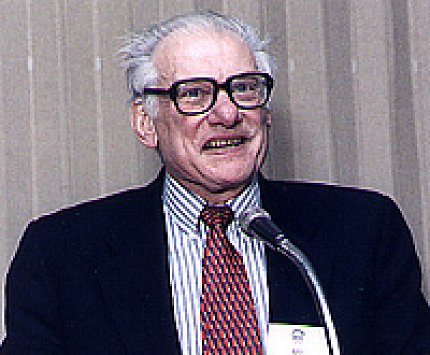NINDS Mourns Scientist Emeritus Kopin

Dr. Irwin J. “Irv” Kopin, scientist emeritus and retired scientific director, NINDS, died on Aug. 1 at age 88.
Kopin was a giant in catecholamine research. His groundbreaking work on the characteristics and metabolism of catecholamines—a class of chemicals that includes adrenaline, norepinephrine and dopamine—provided the backbone for major advances in neurological and psychiatric disorders.
Born in 1929, Kopin graduated from the Bronx High School of Science in New York in 1946. He attended the City College of New York for 2 years and then transferred to McGill University in Canada, where he earned his bachelor of science in biochemistry in 1951 and his medical degree in 1955.
During his second year of medical residency at Boston City Hospital, he joined the Public Health Service and was assigned as a statistician on a tuberculosis research team.
Kopin began his NIH career as a research assistant in the Laboratory of Clinical Science (LCS) at NIMH in 1957, under the direction of Dr. Seymour Kety. Kopin left NIH briefly in 1960 to finish a 1-year medical residency at Columbia-Presbyterian Medical Center. Upon completion, he immediately returned to LCS as a clinician-scientist. In 1969, he became LCS chief, a position he held until 1983. He led the lab during the early days of neuropsychopharmacology, side by side with renowned scientists such as Nobel laureate Dr. Julius Axelrod and Kety.
With Axelrod and others, Kopin published numerous research articles dealing largely with the disposition and metabolism of catecholamines.
Kopin proposed the notion of false neurotransmitters, referring to a chemical compound that mimics the action of a neurotransmitter. He also showed that the chemical 1-methyl-4-phenyl-1,2,5,6-tetrahydropyridine rapidly produces a “time-telescoped” form of Parkinson’s disease. This finding was not only pivotal for Parkinson’s research but also provided a key link to neurology for Kopin.
In 1983, then-NINDS director Dr. Murray Goldstein appointed Kopin scientific director of NINDS, a position he held for 11 years, until 1994. During this time, he also served as chief of the Clinical Neuroscience Branch until 1999.
With his broad knowledge of neuroscience and medicine, Kopin strengthened both the basic and clinical neuroscience programs at NINDS. He was collaborative in his managerial duties as well, and he developed a novel and effective NINDS administrative triad with Dr. Mark Hallett, who was the clinical neuroscience director, and Dr. Ernst Freese, who was the basic neuroscience director and chief of the Laboratory of Molecular Biology, and later, Dr. Harold Gainer, who became basic neuroscience director after Freese.
“Irv was very bright, allowing him to have a good and broad understanding of all the activities in the institute,” said Hallett. “This allowed him to judge what research should get supported. He was always fair and transparent. He used to say that he needed to be honest all the time because his memory wasn’t good—not true of course—so that he wouldn’t ever contradict himself. His intelligence came out in interesting ways. For example, he was in charge of controlled substances in NINDS, which were kept in a safe. When he went on vacation, I was his deputy, so I had to know how to open the safe. The code was the first part of the Fibonacci sequence.” [The Fibonacci sequence is a series of numbers in which each number after the second number is the sum of the two preceding numbers.]
Kopin officially retired in 1999 and became a scientist emeritus and active participant in NINDS’s clinical neurocardiology section until just before his death.
Throughout his career, Kopin demonstrated an unflagging commitment to the NIH mission and more generally to advancing medical scientific knowledge. He served on numerous committees, participated on many scientific advisory boards and served as a co-editor or editorial board member for more than 20 scientific journals. His awards included the PHS Distinguished Service Medal in 1980 and 1990, an honorary membership in the Royal Society of Medicine in 1993 and the Paul Hoch Award for Distinguished Service in 2004.
He authored or co-authored more than 730 articles, reviews and book chapters. He continued to publish papers vigorously during his retirement, with the last appearing this past May.
Kopin was a mentor and role model for scores of postdoctoral researchers, many of whom now occupy key positions in academic medicine or the pharmaceutical industry. His collaborations with leaders in the field provided the foundation for much of what is known today about catecholamine systems, both inside and outside the brain.
Dr. David S. Goldstein, chief of the NINDS clinical neurocardiology section, was one such person touched by Kopin: “I had the privilege of knowing and working with him for over 35 years. Our typical style of communication was debate, in the best Talmudic tradition of the ‘chevrusah,’ or learning partner. Together we argued about interpretations of the data, experiments that should be done, conceptual models, getting the historical facts straight and, most recently, about how to link genetics and molecular biology with integrative physiology. In the dedication to a book I wrote recently, I referred to Irv as ‘an example of intellectual rigor, productivity, perspective and integrity, an inspiration throughout my career at the NIH.’ I look at his empty desk in the lab and, while of course saddened, I also feel thankful and honored that he was my medical scientific chevrusah for so many years.”
Kopin is survived by his wife Rita, his son Alan, daughters Gail and Judye, and 8 grandchildren. The family asks that memorial contributions may be made to Congregation Beth El, the Dana-Farber Cancer Institute or to MAZON—A Jewish Response to Hunger.
